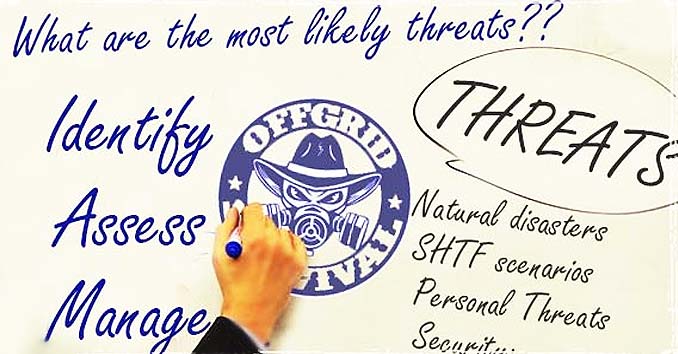
When it comes to emergency preparedness, there is no such thing as a one size fits all survival plan. It just doesn’t exist; and if anyone ever tries to sell you on an easy one size fits all preparedness method, they are either lying to you, or they don’t have the first clue what it takes to survive a real-life crisis.
Listen, I could go on and on listing ten thousand different threats a person could face during their lifetime, giving you an easy to digest ten-point plan for survival, but the truth is most of those ten-point plans suck. They’re not realistic. They don’t take into account your very unique needs, location, or situation.
Like it or not, YOU are going to have to put in a little work!
What is a Preparedness Threat Assessment?
It’s the only way to truly be prepared! I mean how many people living in Middle America really need to understand everything there is to know about preparing for Hurricanes? They don’t; the threats they face are not the same threats as those living in Tornado Alley.
To truly be prepared for anything, you need to know exactly what threats you’re facing, and then analyze how those threats will affect you in the future. A threat assessment allows you to really dig down and identify potential dangers that you may face both during and after a disaster. By performing a realistic threat assessment, you can get a better idea of what threats are out there, and then learn how to prepare for those threats before they become a danger to your life.
Performing a threat assessment will help you improve your ability to handle threats, manage threatening situations without stress, and protect the people you love from harm.
There are three primary objectives when performing a threat assessment:
- Identify
- Assess
- Manage
So take out your notebook, and let’s get started.
IDENTIFY The Threats
The first step in analyzing your overall preparedness level is to identify the most likely threats that you will face.
What are the most likely threats that you will face? Who/What are the threats, and what are your vulnerabilities?
- Natural disasters: What are the most likely disasters you will face based on your geographical location? (Hurricanes, Floods, Earthquakes, etc…)
- SHTF scenarios: What do you believe are the greatest threats to your livelihood? (Economic collapse; political instability; chemical, biological, radiological, and nuclear threats; riots; wars; etc…)
- Personal Threats – Economic Problems, Job Loss, Home Invasions, Debt, etc..
- Security: What are the largest security risks that you face in your area? (Gangs, Criminal Activity, issues affecting urban areas, etc…)
- What are the immediate dangers in your location? Is there anything that stands out about your neighborhood? Are there obstacles or dangers that are specific to your geographical location that could leave you vulnerable? (terrorist threats, chemical and/or biological threats, threats to critical infrastructure, criminal activity, inadequate access to supply routes or escape routes during a disaster, etc…)
ASSESS The Threats
The next step is to assess how these dangers will affect you, and then figure out what needs to be protected?
- How will each of the threats that you listed above affect you, your family, your property, and your survival plans?
- How will each situation affect your overall preparedness efforts?
- Are there any areas in your plans, security, or overall preparedness efforts that need to be addressed?
- What steps do you need to take to protect yourself, your family and your property?
MANAGE The Threats
The final step is to take immediate protective actions that will help prevent, or minimize your exposure to these potential threats.
- What can be done to minimize your risk?
- Develop appropriate emergency response plans and threat reduction strategies for each situation.
- Are you prepared to Bug Out if the situation calls for that action?
- Intelligence – Those that are truly prepared will seek information from multiple sources. Make sure you have a good way to gather information before and after the disaster hits. (BEFORE: Survival Websites, Books, Radio etc… AFTER: Personal Networks, Ham & Shortwave Radio, etc…)



Here where I live and I’m not going to give out the location we are faced with a number of problems.
1. More earthquakes thanks to the fracking going on…
2. Prone to flooding due to frequent storms in the spring time.
3. We are also prone to tornadoes as well.
4. High crime in my area. Lots of gangs and drug dealers. Plus the apartment complex next door to mine has a lot of these said drug dealers and prostitutes.
5. There are a lot of crazy fucking people coming out of the wood work lately. Just within the past three weeks, I was been by two crazy women within the span of only four to five days.
Get yourself as ready as you can, then try a trail run. Go to the breaker box and shut off the power for a week. Any deficiencies will become obvious, and you will have time to correct them.